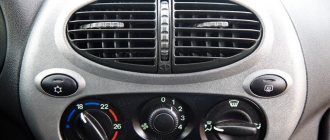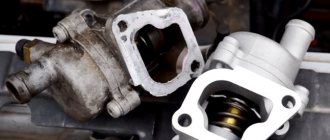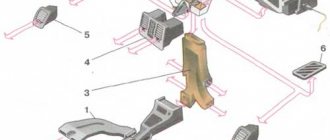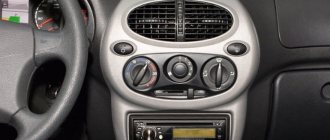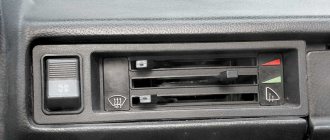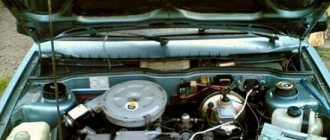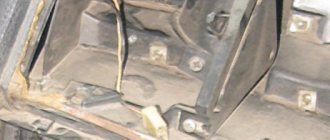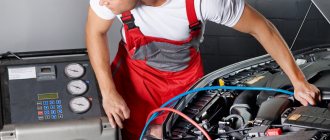Sometimes motorists are faced with the fact that the stove only heats up at the speed of the VAZ 2114. Why does the stove on the VAZ 2114 get airy? The reasons for this phenomenon can be very different, and in some cases very serious (for example, burnout of the cylinder head gasket). That is why, when faced with the fact that the stove is not functioning correctly, you should immediately begin searching for probable causes.
Stove VAZ 2114
The principle of operation of the stove in the car
The vehicle heating system includes:
- heater radiator;
- pipes;
- Control block;
- coolant pump (pump);
- heater tap.
The process of heating the car interior goes like this:
- Coolant circulates in the system due to the operation of the pump.
- During the heating process of the engine, heat is removed from it.
- Hot coolant enters the radiator, heating it.
- The stove fan takes air from the engine compartment and then supplies it to the cabin through the heater radiator, which heats it up.
- This cools the fluid as a result of heat exchange (the engine receives cool antifreeze, and the interior receives a flow of warm air).
This is how the heating system in most cars works. Accordingly, the temperature of the air that enters the car interior depends on the performance of various system components.
The main reasons why the stove does not heat well at idle:
- malfunction of the water pump (pump);
- air lock in the system;
- lack of coolant;
- burnout of the cylinder head gasket;
- malfunction of the stove tap;
- clogged pipes and heater radiator;
- thermostat malfunction;
- internal damage to the heater radiator.
Now let's look at how to determine the presence of each of these problems.
Heating system VAZ-2114
The VAZ-2114 interior heater consists of the following elements:
- radiator with pipes;
- supply shut-off valve;
- frame;
- air ducts;
- dampers;
- fan;
- Control block.
Heating of the air supplied to the cabin is carried out by passing the air flow through the honeycombs of a heat exchanger - a radiator, through which coolant heated by the engine circulates.
The VAZ-2114 heater has the ability to shut off the supply of antifreeze to the heater radiator, so the heating system is turned off (for the summer period). The supply is stopped using a tap embedded in the coolant supply pipe to the heater radiator.
The radiator is installed in the heater housing. In addition to housing the component elements of the stove, the housing prevents the dispersion of air flow and directs its movement.
We recommend: Rating of the best oils for high mileage engines in 2022
The heater body is connected to air ducts, with the help of which it supplies heated air flow to the areas of the windshield and side windows, to the middle of the cabin, to the feet of the driver and front passenger. To adjust the direction of air flow, deflectors are installed at the ends of the air ducts that supply heat to the side windows and into the middle of the cabin.
The distribution of air flow across zones is ensured by dampers installed in the housing. The design of the VAZ 21-14 stove uses three dampers:
- Stove control damper. It redirects the air flow through the radiator (the stove is operating) or bypassing it (the system is operating in interior ventilation mode).
- Damper for supplying flow to the windshield area.
- Damper for redirecting warm air to the footwell area or to the side windows and into the passenger compartment.
Thanks to the dampers and the heater tap, the driver activates the interior heating system, controls the air flow, choosing which zone it should be supplied to.
The fan included in the heater design creates an air flow. Thanks to the power supply circuit of the fan electric motor being equipped with rheostats, the unit received three operating modes in which the fan rotates at different speeds.
Unlike the heating systems of cars of the classic family - VAZ-2101-2107, the fan in the VAZ-2114 forces air into the heater body, rather than drawing it in, which increases the efficiency of air supply. Therefore, this unit was installed not inside the housing, but on it. Access to the fan has become easier, since on the VAZ-2114 it is located in the engine compartment, in a niche near the engine shield.
Pump malfunction
Very often, drivers explain poor performance of the heater at idle by a breakdown of the water pump. This is due to the fact that at XX the pump impeller rotates at low speed, which cannot ensure high-quality circulation of antifreeze (antifreeze). As a result, heat exchange deteriorates and insufficiently hot air enters the cabin. When you press the gas pedal, the speed of rotation of the impeller increases, which immediately entails an increase in the air temperature in the cabin.
For more accurate diagnostics of the pump, it must be removed from the engine. Very often, a pump malfunction is accompanied by overheating of the motor. A visual inspection of the item will indicate its condition. If the impeller is jammed, spins on the shaft, or its blades are scattered, the pump must be replaced.
Fuses, relays
One of the simplest and at the same time unpleasant breakdowns is fuses. The malfunction is simple, because replacing the fuse is easy. But this breakdown becomes unpleasant due to the fact that it is difficult to find out why the fuse blew. Often, these elements in VAZ cars burn out due to short circuits in the wiring. Fuse F7 is responsible for the operation of the stove in these models.
Air lock and lack of coolant in the system
This is an easily fixable problem. The culprit may be a faulty expansion tank cap that is unable to maintain the required pressure in the system. Another reason for the formation of traffic jams is a lack of coolant. Poor circulation leads to the stove blowing cold air at idle. When the car starts moving, the air temperature rises, and after stopping it drops again.
To eliminate the problem, you need to check the antifreeze level and, if necessary, add coolant. Also check the system for leaks and repair any leaks if found. Often pipes leak at the joints, but the radiator itself may be the culprit. If the reservoir cap does not work, replace it with a known good item.
After this, you need to get rid of the air in the system by installing the machine on a hill or overpass so that its front part is higher than the rear. Start the engine and open the expansion tank cap. Excess air should be released from the system. If after some time the plug appears again, this may be a sign of a cylinder head gasket failure.
Lada 2114 Music is My Life. › Logbook › Stove 2114 does not heat up at idle
This is perhaps one of the very few posts not about car audio. To be honest, I would even say this is a cry from the heart, so I will write a lot) The entry is dedicated, as the title suggests, to problems with the stove.
And so, the point is that throughout the entire time I owned this car, which was about three years, I had one problem with the stove - IT WOULDN’T HEAT AT IDLE. I solved this problem just now! Because, to be honest, this really bothered me! Why did it take so much time to resolve, the question may arise? I will say this, because in fact, there are quite a lot of reasons for a stove that heats poorly, does not heat at all, or only heats while it is running, so it is difficult to get to the bottom of it right away. I read a LOT of forums on the Internet, including on the drive by the way) and a lot of reasons why this could be. And then I will write these reasons, and explain what symptoms were accompanied specifically by my problem, because this entry can help an unfortunate and desperate person like me, like me) I’ll start with the worst.
1. The cylinder head gasket has burned out or is starting to burn out. Let me say briefly, if it burns out, you will definitely not have time for the stove)) since it is antifreeze in oil or vice versa, blown pipes, clouds of blue smoke... in general, oh oh. BUT, while looking for a solution to the cause of my problem, I more than once came across records of people whose gaskets allegedly just started to burn out, and the symptoms are very similar. Everything seemed to be fine, but the stove had already stopped heating)) In general, in desperation, I decided to change that same gasket, and voila! Fuck there! everything remains as it was, so if none of the things listed below help you, then soon you will get money, but don’t rush into it))
2. Pump. A lot and most often they write that the problem is in a poorly pumping pump, they say it has either turned over there, or is worn out, or is simply acting up... the consequence is poor coolant circulation at idle, the stove does not heat, etc.... In general, IMHO, this is all complete crap and rave! since you probably already guessed, I changed it too. Result - 0! Why is this crap? You know, the pump either pumps or it leaks, and the car is boiling, well, and there is a consequence of the cylinder head gasket and all that stuff... there’s no other way! verified.
3. Heater radiator. I’ll say this, on a car with an identical problem they changed it, guess the result)) that’s right, it didn’t do anything)) Many people also write that it’s clogged, or it’s simply not of good quality in itself, etc... yes, undoubtedly, this is an option. BUT I’ll tell you this, you have to try very hard to clog the radiator. On the car where they changed it (in fact, that’s why they thought it was him), TWO tubes of sealant were poured into the system... it’s like it can clog the system)) but we opened the removed radiator)) and there were only a couple of trash cans) and nothing else)) From this I concluded that you need to make a specific effort to clog the radiator)) If it’s leaking, then no doubt, change it)) but if it’s dry... then it’s unlikely that’s the reason)) although who knows
4. Here I will write several reasons at once, so as not to prolong the writing) - air lock. it’s easy here)) we stood on a steep hill or overpass, opened the expander, accelerated), the fan worked, went out, close the lid. Did it help? you are lucky) but take your time, drive a little)) is the problem back? you are unhappy like me))) - expansion tank cap. Does not hold pressure, does not relieve pressure, poor coolant circulation, life pain, etc. costs 150r. try it)) if it helps, you're lucky. BUT its malfunction is accompanied by inadequate behavior of the temperature arrow, so...) see for yourself)
5. The stove tap is not fully open. well check)
IN GENERAL, I got all this from the Internet)) BUT I didn’t see the reason why I had problems anywhere!
It was the thermostat! Yes! But everyone I asked said, what does all this have to do with it? If it jams, then the car either boils or does not heat up at all, does it hold 90? Well then it’s definitely not him! Well, I believed it...) And I puzzled further. After all the options I tried, I didn't know what to think. you're standing there cold... you rev it up a little, then it's immediately hot... idk... poor circulation yes... but why? pump is ok! new! no air! The radiator is not clogged! but what else? I suggested that the thermostat might simply not be closing the large circle enough... and the car warms up... and stays at 90, but the circulation at idle turns out to be in the wrong direction, as they say, and in the wrong way (specifically, the bitch in the oven)) In general, it turned out to be so!)) happy and that's all))
Failure of the cylinder head gasket
You need to understand that damage to the cylinder head gasket leads to mixing of oil with antifreeze or exhaust gases entering the cooling system. Usually the problem is quickly diagnosed by obvious signs. But some drivers note that minimal burnout of the gasket may be accompanied by the appearance of excess air in the cooling system.
The only solution may be to replace the cylinder head gasket, but we advise you to take your time and check all other factors first. This is an expensive procedure and a rare problem, so save it for last.
Stove valve malfunction
All cars use a valve that shuts off the flow of coolant through the heater radiator. It is he who is controlled by the “heat - cold” switch on the center console in the cabin. For various reasons, the faucet may not open all the way. In this case, the stove does not heat up at idle speed, since not enough hot antifreeze enters the radiator.
The solution is simple - the faucet must be replaced. We advise you to choose high-quality spare parts, since cheap taps quickly fail and jam in the closed or open position.
Clogged pipes and heater radiator
During the operation of the car, dirt accumulates in the pipes and the radiator itself. This may occur due to the use of low-quality coolant or its untimely replacement. As a result, circulation in the system deteriorates, which is why there will be no heat at idle.
The way out of the situation is to flush the entire cooling system. It is necessary to drain the antifreeze, add distilled water, adding a small amount of citric acid. There are also special cleaning products. We recommend washing in several stages. In very difficult cases, it is better to replace the stove radiator.
Thermostat malfunction
Sometimes the thermostat can become stuck open. As a result, antifreeze will constantly circulate in a large circle. Accordingly, it will not be able to warm up normally. In some cases, the thermostat simply does not completely close the large circle. This has virtually no effect on engine operation, so diagnosing the problem is difficult.
The solution is to check the thermostat and replace it if a malfunction is detected.
Internal damage to the heater radiator
In addition to a clogged radiator, some VAZ car owners have discovered another factor why the heater blows cold air at idle. In the heater radiator there is a partition between the coolant supply and outlet pipes. It may crack or crumble, preventing proper fluid circulation inside the radiator.
The problem can only be detected after disassembling the radiator, so it is better to have a working part on hand to check. If installing a working radiator solved the problem, you can simply throw away the old one. It is unlikely to be repaired.
Warmth in the car interior is an indispensable attribute of a comfortable trip in winter. And in the summer, the stove has its own function of local ventilation.
Like any other device, it can fail. This article will discuss why the stove on a VAZ 2114 does not heat up and how to make the stove heat up better on a VAZ 2114.
As experienced craftsmen say, there can be many reasons why the stove on a VAZ 2114 does not heat well. In order to skillfully and quickly select the right one from all sorts of problems, you need to clearly understand what this heating system is.
It's cold in the VAZ 2114
ADVIСE
How to make the stove heat better on a VAZ 2114?
Alternatively, you can install an additional pump that will forcibly increase the circulation of antifreeze in the cooling system.
An additional pump is installed in the engine compartment and is attached closer to the heater radiator in the cabin. The pump is usually taken from the Gazelle, and the hose from the block head to the stove is moved to the direct outlet of the additional pump. Using an additional L-shaped hose, we connect the other outlet of the pump (standing perpendicular to the pump body) with the heater radiator. The hose will fit from the VAZ classic stove. To operate the additional motor, we connect its negative wire to body ground, and power the positive wire through an additional button in the cabin (power supply +12 volts).
Causes of malfunctions
The starting operation of the fan in the heating system is disrupted
If such a malfunction occurs, the stove will have to be disassembled to find the breakdown. But before that, you need to start the car and turn on all three fan power levels in turn. If there is no additional noise, then it’s time to start disassembling.
Also, in a VAZ 2114 the stove does not heat if the thermostat is faulty. With such a breakdown, the coolant circulates in a circle without having time to cool.
Accumulated air lock
An air lock in the cooling system can form if the engine has already stopped running. At this point, the coolant temperature begins to drop. It is then that air can leak into the upper part of the radiator, and then it moves to the thermostat. Later, when the engine is started again, the pump will drive the accumulated air from the thermostat into the radiator of the heating system.
Helpful advice: to easily free yourself from the air lock, you need to remove the pipe and slowly fill in antifreeze to the maximum mark.
Faulty faucet
Attention, the most common reason. In nine out of ten cases, this is a faucet that does not open completely. This problem can have two reasons: it is completely out of order and needs to be replaced, or it is poorly secured and due to the heater cable, which is located near the pedal assembly. The cable needs to be tightened a little by grabbing it with pliers.
If at the same time the stove does not supply hot air to the cabin, and the faucet is leaking, then the latter must be urgently replaced. At such a moment, a greasy coating forms on the glass, and the same stains may appear on the floor, and a pronounced smell of antifreeze and antifreeze hovers in the atmosphere of the cabin.
Heater valve VAZ 2114
The radiator is clogged in the heating system
If the heater radiator is clogged with dirt and debris, then the heater does not blow well and the flow of warm air enters the cabin barely noticeable. This is especially unpleasant if there is decent frost behind the glass.
The quality of the radiator in the heating system leaves much to be desired
This kind of news about the performance properties of their radiator is most often received by car owners who bought a used VAZ 2114 back in the summer. And before the onset of cold weather, they do not even suspect the upcoming problems. Also, a bad radiator can be installed at a car service center. A gullible customer who did not control the result of the master’s work may become a victim of deception and negligence. In any case, a bad radiator will have to be replaced with a high-quality one. There are no options here.
Heater radiator VAZ 2114
Radiator replacement procedure:
- Disassemble the front panel and remove the console.
- Drain the antifreeze into a special clean container through the radiator or drain hole.
- Remove the center panel, glove compartment, side panels.
- Unscrew the bolts and screws that secure the panel to the body and metal.
- Remember about the cables in time.
- Move the released dashboard to the side.
- Remove the pipes.
- Remove the old radiator and replace it with a new one.
- Screw all other serviceable parts into their original places.
Problems with the cooling system
When the heater on a VAZ-2114 does not work, reasons other than electrical may lie in the coolant circulation system:
- Air lock . As the coolant cools, air accumulates in the upper part of the radiator. Subsequently, air enters the thermostat and a large circle of coolant movement is blocked. The heater core remains cold. There are many ways to fix the problem. But the easiest thing is to squeeze out excess air from the system. To do this, unscrew the cap from the tank. With the engine running, the cold hose is intensely compressed, causing air to escape into the reservoir. If this method does not work, you will have to disconnect the hose to remove the air lock.
- Radiator . Few people devote time to maintaining their car, and especially the heating system. The internal space becomes clogged with dirt, which impedes the flow of coolant. The outer multi-cellular surface becomes clogged with dust and foreign objects, which interferes with heat transfer. In this case, only cleaning the radiator and replacing the cabin filter will help.
- Water pump . Wear of intake blades leads to a decrease in productivity and, consequently, a drop in pressure. Reduced idle pressure is unable to supply heated coolant to the radiator. Only high engine speeds allow you to create the necessary pressure.
- Low coolant level. An antifreeze level below the minimum provokes airing of pipelines. You just need to add antifreeze to the maximum level.
- Cylinder head gasket . A gradual decrease in coolant level, intense white smoke from the exhaust system and the smell of gasoline (oil) in the tank indicate a burnt-out gasket. Through the gap that appears, antifreeze enters the cylinders and into the crankcase with oil. Replacing the gasket requires removing a large number of parts.
- Thermostat . The operating principle of the thermostat is based on the property of a certain metal to change its original shape when the temperature rises. If the element fails, the coolant moves in a small circle without entering the heater radiator. In this case, only replacing the thermostat will help.
- Faucet. It regulates the flow of coolant, that is, the temperature inside the car. If it breaks, the fluid flow stops. Although it is held on by two screws, it is installed in a hard-to-reach place, under the dashboard, which is associated with certain difficulties.
- Hoses . Connecting rubber hoses become unusable after prolonged use. They crack and break. Through the formed cracks, the system depressurizes, and consequently, antifreeze leaks, air gets inside, etc.
Prevention methods
To avoid a reoccurrence you will need:
- The first preventative measure is to disassemble the system in advance and clean every part.
- The presence of a clean cabin filter under the hood. As you understand, a dirty and clogged filter prevents the passage of hot air, and for the same reason the radiator becomes covered with a large layer of dirt.
- Fresh antifreeze. It needs to be changed regularly and maintained at the proper level. Then the air supply to the radiator through the thermostat will be uninterrupted.
- Hermetically sealed faucet and radiator. This can be verified when the engine is well warmed up.
A functioning heating system will be confirmed by the silent, well-functioning operation of the fan and a continuous flow of warm air even when the car is static.
If the VAZ-2114 stove does not work, this may not cause any special problems in summer and spring. But during the cold season, the lack of heat inside the cabin significantly affects the level of comfort. Do not forget that in the spring and summer the ventilation functions are partially assigned to the stove. So a stove that properly performs its tasks is an important component for every VAZ-2114 owner.
Causes of malfunctions
In some cases, the fact that the furnace is blowing cold air is normal. For example, when you turn it on in ventilation mode. But if you switch to heating mode, but the heater is not going to blow hot air, you are faced with a breakdown.
Specialists at the service station will tell you that there can be many reasons for the breakdown. This is another reason to take more money. Therefore, it is in your interests and for reasons of economy to check each reason yourself. Besides, it's not that difficult. Among the main reasons why the stove on the VAZ-2114 stopped working and producing hot air may be:
- broken fan;
- airlock;
- stove tap;
- radiator;
- insufficient pressure;
- antifreeze deficiency;
- cylinder head gasket;
- motor.
As you can see, there are enough options for why the system stopped working.
Important! If you decide to do the repairs yourself, start with the most likely and simplest reasons for the failure of the heating system. It is better to entrust complex stages in the absence of relevant experience to specialists.
Fan
Warm or hot air may not flow from the stove if the fan is not activated from the start. In this situation, you will have to completely disassemble the stove and look for the cause inside it.
To avoid unnecessary dismantling work, start the engine and turn on in turn all the power levels at which the fan operates. If there is no noise or any movement, then you will still have to disassemble the system and change the fan or its motor.
Important! The thermostat is another potential culprit when the heater does not want to turn on. A faulty thermostat causes the coolant to circulate, but does not have time to cool.
Airlock
Quite often, VAZ-2114 stoves do not heat well due to the fact that an air lock has formed inside the cooling system. It appears mainly in cases where the engine has already stopped working. From this moment on, the temperature of the coolant begins to drop. In such situations, air is able to leak into the upper part of your VAZ-2114 radiator, after which the plug penetrates the thermostat.
The next time you start the engine, the heater may not turn on. This is due to the fact that when the engine starts, the pump drives accumulated air through the thermostat into the heater radiator. In some cases, because of this, VAZ-2114 stoves only heat up at speed. Therefore, before sending the car to a service station, simply try to get rid of air in the system. Although there are other possible reasons for the lack of heat at idle and its appearance after pressing the gas. This is the heater valve or the same cylinder head gasket.
How to replace a heater motor with your own hands?
Remove the trim on the driver's side. Then disconnect the black and blue wires of the motor. Unscrew the mass fastening. After this, open the hood and remove the windshield wiper wiring. Next, unscrew the fasteners of the wiper panel and remove the rubber seal. Then unscrew the four screws that secure the upper casing of the stove motor. Next, you need to pull the power wires through the seal. To get the engine itself, its housing must be divided in half. If you turn half of the housing together with the motor, you can get it out.
All that remains is to install the new motor in place of the old one, secure it and connect it to the system.
